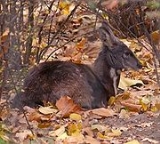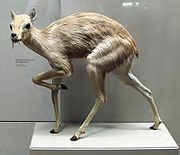
Musk deer
Encyclopedia
Musk deer are artiodactyls of the genus Moschus, the only genus of family
Moschidae. They are more primitive than the cervids, or true deer
, in not having antler
s or facial glands, in having only a single pair of teats, and in possessing a gall bladder, a caudal gland, a pair of tusk-like teeth and—of particular economic importance to humans—a musk
gland. Moschids live mainly in forested and alpine scrub habitats in the mountains of southern Asia
, notably Himalayas. Moschids are entirely Asian in their present distribution, being extinct in Europe
where the earliest musk deer are known from Oligocene
deposits.
is similar to that of true deer:
The musk gland is found only in adult males. It lies in a sac located between the genitals
and the umbilicus
, and its secretions are most likely used to attract mates.
Musk deer are herbivores, living in hilly, forested environments, generally far from human habitation. Like true deer, they eat mainly leaves, flowers, and grasses, with some mosses and lichens. They are solitary animals, and maintain well-defined territories, which they scent mark with their caudal glands. Musk deer are generally shy, and either nocturnal, or crepuscular
.
Males leave their territories during the rutting season, and compete for mates, using their tusks as weapons. Female musk deer give birth to a single fawn after about 150–180 days. The newborn young are very small, and essentially motionless for the first month of their life, a feature that helps them remain hidden from predators.
Musk deers have been hunted for their scent glands which can fetch up to $45,000/kg on the black market. It is rumored that ancient royalty wore the scent of the musk deer and that it is an aphrodisiac.
 Musk deer may be a surviving representative of the Palaeomerycidae
Musk deer may be a surviving representative of the Palaeomerycidae
, a family of ruminants that is probably ancestral to deer
. They first appeared in the early Oligocene epoch and disappeared in the Pliocene. Most species lacked antlers, though some were found in later species. The musk deer are however still placed in a separate family.
Family (biology)
In biological classification, family is* a taxonomic rank. Other well-known ranks are life, domain, kingdom, phylum, class, order, genus, and species, with family fitting between order and genus. As for the other well-known ranks, there is the option of an immediately lower rank, indicated by the...
Moschidae. They are more primitive than the cervids, or true deer
Deer
Deer are the ruminant mammals forming the family Cervidae. Species in the Cervidae family include white-tailed deer, elk, moose, red deer, reindeer, fallow deer, roe deer and chital. Male deer of all species and female reindeer grow and shed new antlers each year...
, in not having antler
Antler
Antlers are the usually large, branching bony appendages on the heads of most deer species.-Etymology:Antler originally meant the lowest tine, the "brow tine"...
s or facial glands, in having only a single pair of teats, and in possessing a gall bladder, a caudal gland, a pair of tusk-like teeth and—of particular economic importance to humans—a musk
Musk
Musk is a class of aromatic substances commonly used as base notes in perfumery. They include glandular secretions from animals such as the musk deer, numerous plants emitting similar fragrances, and artificial substances with similar odors. Musk was a name originally given to a substance with a...
gland. Moschids live mainly in forested and alpine scrub habitats in the mountains of southern Asia
Asia
Asia is the world's largest and most populous continent, located primarily in the eastern and northern hemispheres. It covers 8.7% of the Earth's total surface area and with approximately 3.879 billion people, it hosts 60% of the world's current human population...
, notably Himalayas. Moschids are entirely Asian in their present distribution, being extinct in Europe
Europe
Europe is, by convention, one of the world's seven continents. Comprising the westernmost peninsula of Eurasia, Europe is generally 'divided' from Asia to its east by the watershed divides of the Ural and Caucasus Mountains, the Ural River, the Caspian and Black Seas, and the waterways connecting...
where the earliest musk deer are known from Oligocene
Oligocene
The Oligocene is a geologic epoch of the Paleogene Period and extends from about 34 million to 23 million years before the present . As with other older geologic periods, the rock beds that define the period are well identified but the exact dates of the start and end of the period are slightly...
deposits.
Characteristics
Musk deer resemble small deer with a stocky build, and hind legs longer than their front legs. They are approximately 80 to 100 cm (31.5 to 39.4 ) in length, 50 to 70 cm (19.7 to 27.6 ) tall at the shoulder, and weigh between 7 and 17 kg (15.4 and 37.5 ). The feet of musk deer are adapted for climbing in rough terrain. Like the Chinese water deer, a cervid, they have no antlers, but the males do have enlarged upper canines, forming sabre-like tusks. The dental formulaDentition
Dentition pertains to the development of teeth and their arrangement in the mouth. In particular, the characteristic arrangement, kind, and number of teeth in a given species at a given age...
is similar to that of true deer:
The musk gland is found only in adult males. It lies in a sac located between the genitals
Sex organ
A sex organ, or primary sexual characteristic, as narrowly defined, is any of the anatomical parts of the body which are involved in sexual reproduction and constitute the reproductive system in a complex organism; flowers are the reproductive organs of flowering plants, cones are the reproductive...
and the umbilicus
Navel
The navel is a scar on the abdomen caused when the umbilical cord is removed from a newborn baby...
, and its secretions are most likely used to attract mates.
Musk deer are herbivores, living in hilly, forested environments, generally far from human habitation. Like true deer, they eat mainly leaves, flowers, and grasses, with some mosses and lichens. They are solitary animals, and maintain well-defined territories, which they scent mark with their caudal glands. Musk deer are generally shy, and either nocturnal, or crepuscular
Crepuscular
Crepuscular animals are those that are active primarily during twilight, that is during dawn and dusk. The word is derived from the Latin word crepusculum, meaning "twilight." Crepuscular is, thus, in contrast with diurnal and nocturnal behavior. Crepuscular animals may also be active on a bright...
.
Males leave their territories during the rutting season, and compete for mates, using their tusks as weapons. Female musk deer give birth to a single fawn after about 150–180 days. The newborn young are very small, and essentially motionless for the first month of their life, a feature that helps them remain hidden from predators.
Musk deers have been hunted for their scent glands which can fetch up to $45,000/kg on the black market. It is rumored that ancient royalty wore the scent of the musk deer and that it is an aphrodisiac.
Evolution

Palaeomerycidae
Palaeomerycidae is an extinct family of ruminants , probably ancestral to deer and musk deer...
, a family of ruminants that is probably ancestral to deer
Deer
Deer are the ruminant mammals forming the family Cervidae. Species in the Cervidae family include white-tailed deer, elk, moose, red deer, reindeer, fallow deer, roe deer and chital. Male deer of all species and female reindeer grow and shed new antlers each year...
. They first appeared in the early Oligocene epoch and disappeared in the Pliocene. Most species lacked antlers, though some were found in later species. The musk deer are however still placed in a separate family.
External links
- The New Student's Reference Work/Musk-Deer

